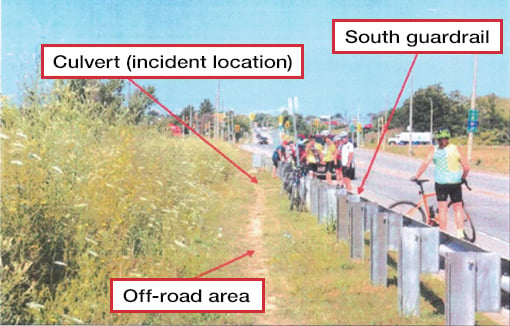The Ontario Superior Court of Justice recently released its decision in Bello v City of Hamilton, 2024 ONSC 5457, granting summary judgment in favour of the defendant municipality based on a statutory provision in the Municipal Act addressing damages occurring on the “untravelled portion of a highway.” This decision reiterates the law on this provision, which can provide a complete defence to municipalities in certain situations.
Background
The plaintiff was cycling with a group on Aug. 4, 2019, when he rode into a culvert situated on an “off-road path” adjacent to Stone Church Road East in Hamilton. Tragically, he broke his neck and was rendered a tetraplegic. The Plaintiff subsequently commenced a claim in negligence as against the City of Hamilton, seeking $22 million in damages.
The defendant did not dispute that the accident occurred on municipal property adjacent to a roadway but asserted that the plaintiff’s claim was statute-barred by virtue of s. 44(8) of the Municipal Act, which provides that no claim for damages shall be brought against a municipality in respect of an accident occurring on an “untravelled portion of a highway.” The Municipal Act does not define this term, so the central issue on the defendant’s summary judgment motion was whether s. 44(8) applied to the loss location.
The court’s decision includes the photograph below, which depicts the loss location as well as the adjacent roadway, which notably included a designated bicycle lane:

The summary judgment decision
The court began by disregarding the plaintiff’s expert’s evidence as to how the loss location should be characterized, and ultimately noted that the accident occurred on the untravelled portion of the highway.
The court then engaged in a detailed historical review of the jurisprudence interpreting an “untravelled portion of a highway,” noting that the provision in question dated back over 80 years. Though each case turned on its own facts, the court held that the overarching purpose of s. 44(8) was to insulate a municipality from liability for any accident occurring on a portion of the highway that was neither “provided and intended for ordinary and normal use for the purpose of travel” nor “commonly and habitually used by the public for that purpose.”
The court also held that the evidentiary record before it was full and complete, such that it would be appropriate to grant summary judgment. Notably, it distinguished certain older decisions in which summary judgment was not granted under s. 44(8) on the basis that they were decided before the Supreme Court of Canada lowered the bar for summary judgment in the seminal case of Hryniak v Mauldin.
Ultimately, the court held that the off-road path in this case was an untravelled portion of a highway and that the plaintiff’s claim was statute-barred as a result. The court relied heavily on the fact that the municipality had installed bicycle lanes on both sides of Stone Church Road, and thus could reasonably have expected cyclists to use those lanes rather than going off-road. It rejected the plaintiff’s argument that the loss location was commonly used by the public given that a “worn-down path” was visible, as the plaintiff led no evidence as to when that path was created, which may have been prior to the installation of the bicycle lanes. In the final analysis, the plaintiff was held to have knowingly pursed an unusual course that invited danger by declining to use the bicycle lanes provided by the municipality.
Commentary
This decision helpfully clarifies the law in respect of a statutory provision that has received relatively little judicial commentary. This decision reminds municipalities of the availability of a useful defence in defending claims arising out of accidents that occur beyond the traveled portion of the roadway.




